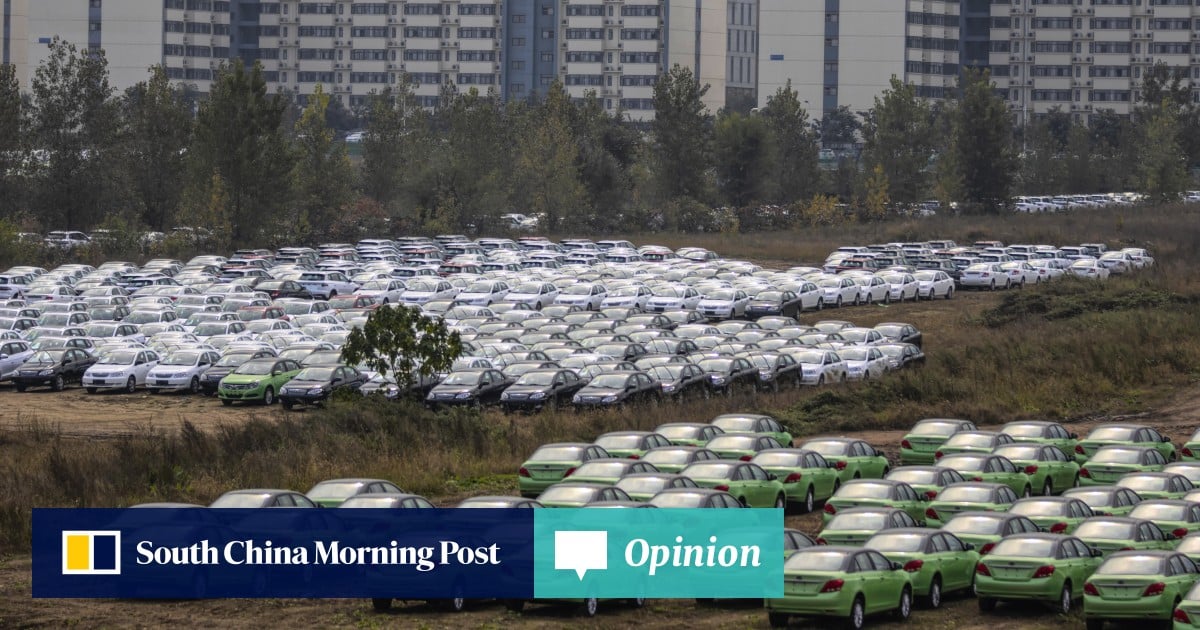How Beijing Is Trying To Hide The Economic Damage From The US Trade War

Table of Contents
Manipulating Economic Data Reporting
Beijing's response to the trade war involved sophisticated manipulation of economic data reporting, aiming to present a picture of resilience that may not reflect the reality on the ground. This involved altering key economic indicators to minimize the apparent impact of the trade conflict.
Altering GDP Growth Figures
One primary method employed was the inflation of GDP growth figures. While China's official GDP growth numbers often appear robust, inconsistencies arise when compared to other economic indicators. For example, growth in industrial production or retail sales might lag behind the reported GDP growth, suggesting a possible disconnect.
- Data Manipulation Techniques: These may include adjustments to the weighting of different sectors in the GDP calculation, or revisions of historical data to smooth out fluctuations.
- Alternative Data Sources: Independent analyses of freight transport volumes, electricity consumption, and purchasing manager indices often provide alternative perspectives that sometimes contradict the official data. These discrepancies raise questions about the accuracy of the reported GDP figures and the extent to which they reflect the true economic impact of the trade war.
Underreporting Unemployment and Business Closures
The Chinese government also faced the challenge of managing the narrative surrounding job losses and business failures. Sectors heavily reliant on exports, such as manufacturing and agriculture, were particularly vulnerable to the trade war's tariffs. However, official unemployment statistics might underrepresent the true scale of job losses due to reporting challenges and data collection limitations.
- Sectors Affected: Manufacturing, particularly in export-oriented industries, experienced significant challenges. Smaller businesses and those lacking robust international supply chains were disproportionately impacted.
- Anecdotal Evidence: News reports and independent surveys from affected regions often paint a different picture than official statistics, suggesting higher unemployment rates and a greater number of business closures than publicly acknowledged. The opacity surrounding official data makes independent verification incredibly difficult.
Controlling Information and Narrative
Beyond manipulating numerical data, Beijing exerted significant control over the flow of information to shape public perception of the trade war's impact. This involved both censorship and the promotion of a carefully constructed positive narrative.
Censorship of Negative News
The Chinese government implemented strict censorship to suppress critical reporting on the economic challenges stemming from the trade war. Domestic media outlets faced limitations, preventing them from publishing articles or conducting investigations that presented a negative view of the government's economic policies or the overall economic impact of the trade war.
- Censored News Reports: Reports detailing business closures, job losses, and economic hardship were frequently suppressed. This control extended to social media, limiting the dissemination of alternative perspectives.
- Foreign Media Restrictions: Access for foreign journalists and researchers was also limited, restricting their ability to independently investigate and report on the economic realities within China.
Promoting a Positive Narrative
To counteract negative perceptions, the government launched extensive public relations campaigns and utilized state-controlled media to emphasize the resilience and success of the Chinese economy. Success stories of specific companies and industries were heavily promoted to overshadow the wider economic difficulties.
- Government Propaganda: State media outlets consistently highlighted the government's proactive measures, emphasizing economic stability and growth despite external pressures.
- Public Relations Campaigns: These campaigns aimed to project an image of strength and economic resilience in the face of adversity, potentially obscuring the genuine challenges faced by many businesses and citizens.
Implementing Economic Stimulus Measures to Mask Problems
To counteract the negative economic effects, Beijing implemented significant economic stimulus measures. These actions, while providing short-term relief, may have also obscured the underlying economic problems and delayed necessary structural adjustments.
Increased Government Spending and Investment
Massive government spending on infrastructure projects helped boost economic activity, creating the illusion of robust growth. This increase in government investment, however, might not reflect a genuine improvement in economic fundamentals.
- Major Infrastructure Projects: The construction of new roads, railways, and other large-scale projects stimulated employment and economic activity, but the long-term sustainability of this approach remains a question.
- Government Spending vs. Economic Growth: Analyzing the relationship between increased government spending and the overall economic growth rate is essential to understanding if this spending genuinely addressed the underlying issues or merely masked them temporarily.
Financial Support for Affected Industries
The government also provided significant financial support to industries hard-hit by the trade war, including loans, subsidies, and tax breaks. These measures created a temporary economic buffer but may have delayed necessary restructuring and created long-term vulnerabilities.
- Sectors Receiving Support: Industries heavily impacted by tariffs, such as manufacturing and agriculture, received considerable financial assistance.
- Sustainability of Measures: The question remains whether these measures created genuine long-term economic health or simply postponed necessary reforms and adjustments.
Conclusion
Beijing's attempts to mask the economic damage from the US trade war involved a multifaceted strategy encompassing data manipulation, information control, and significant stimulus measures. While these actions may have temporarily obscured the true extent of the impact, they did not address the underlying economic challenges. The long-term effects of this approach, including potential long-term economic vulnerabilities, remain to be seen. Understanding Beijing's efforts to hide the true economic cost of the US trade war is crucial for accurately assessing the global economic landscape. Further independent research and analysis are needed to fully understand the long-term consequences and uncover the hidden impact of the trade war on the Chinese economy. Continue to follow updates on Beijing's efforts to mask US trade war damage for a more comprehensive understanding.

Featured Posts
-
 3 Arena Concert Loyle Carner Live In Dublin
May 03, 2025
3 Arena Concert Loyle Carner Live In Dublin
May 03, 2025 -
 13 Kesepakatan Kerja Sama Ri Turkiye Hasil Pertemuan Presiden Erdogan Dan Jokowi
May 03, 2025
13 Kesepakatan Kerja Sama Ri Turkiye Hasil Pertemuan Presiden Erdogan Dan Jokowi
May 03, 2025 -
 Mental Health Awareness Understanding The Silence And Finding Support Dr Shradha Malik
May 03, 2025
Mental Health Awareness Understanding The Silence And Finding Support Dr Shradha Malik
May 03, 2025 -
 Christina Aguileras Transformed Look The Photoshop Debate Ignites Online
May 03, 2025
Christina Aguileras Transformed Look The Photoshop Debate Ignites Online
May 03, 2025 -
 Where To Watch Newsround On Bbc Two Hd A Tv Guide
May 03, 2025
Where To Watch Newsround On Bbc Two Hd A Tv Guide
May 03, 2025
